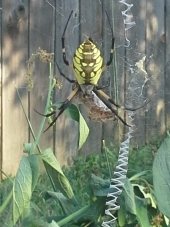posted 6 years ago
We've got ground water everywhere on our slopes, and for the most part it does flow year-round. However a huge portion of it creates swampy/boggy areas down the slope, just sort of resting on the surface and trickling down through the sediment. In some patches it forms a proper small stream, before dispersing again into mosquito-infested mush.
This micro-ecosystem is inhabited mostly by insects, horsetail, willow, arnica, false hellebore (trying to eradicate that one though because of the livestock), baneberry, thimbleberry, and a few other wet-loving plants.
We turned the pigs loose on the areas to see what they'd make of it. They've made some good size wallows and mostly haven't touched the actual 'creek' spots. They've mushed and mashed and reshaped a lot of the boggy spots, so they're still boggy spots just with tiny ponds in them now.
I keep thinking about these areas and in what ways we could shape them to encourage more provision and habitat for the wildlife. We have 1 pond made on the property and it's flourishing wonderfully with amphibians and life. I envisioned maybe mucking out terraced ponds down the hillside. Or just trenching a proper creek. Among other things.
I'm not against bogs. My main complaints are 1: the mosquito habitat, and 2: we want the animals to have fresh drinking water through the dry spell of summer, and the goats don't fancy murky bog water.
My main desires are to foster a source of good clean water that endures most or all of the year, reduces mosquito swarm habitat, encourages wildlife to flourish in the area, and can support some abundantly growing foodstuffs for people, pollinators, and animals alike.
Right now we have 1 slope whose water extends maybe 300 ft downhill, fairly narrow, with the boggy areas spreading no more than 30 feet wide. This slope is boggy in some spots, then turns into a proper creek in other spots as it flows. This gets water from from multiple springs, some feeding into it farther downhill.
The other slop we're working with has the same length, or more, going downhill, with its boggy areas spreading as much as 50-75' wide. Pretty much the entire trips down the hillside is swampy/mushy ground, with not clear-cut creek.
I'm curious to see what suggestions you guys might have for the areas! We're in zone 3, the bogs are in forested draws, but we're thinning the forest to 20-50 feet between healthy trees to open it up a little bit. Most of our substrate is rotten granite gravel. There is a little bit of clay under that about 1-2' down. Otherwise it usually drains really well. The boggy areas are more of a sediment-y black-ish mush zone.









